Diplomatic Bluebook 2015
Chapter 2
Japan’s Foreign Policy that Takes a Panoramic Perspective of the World Map
3.Southeast Asia
(1) Brunei Darussalam
Brunei Darussalam has attained a high economic level and put in place generous social welfare on the back of its abundant natural resources.
Japan and Brunei Darussalam have maintained a good relationship for many years, underpinned by its stable supply of liquefied natural gas (LNG). 2014 marked the 30th anniversary of the establishment of diplomatic relations between Japan and Brunei Darussalam. It was a year in which the relationship between the two countries deepened even further, through such initiatives as the creation of a logo and the minting of a commemorative coin to mark this anniversary. Interaction between young people flourished via the JENESYS 2.0 youth exchange project and the Ship for Southeast Asian Youth Program. In addition, various other proactive initiatives were implemented, including programs focused on promoting Japanese cuisine and other aspects of Japanese culture in Brunei Darussalam, and a cultural exchange program involving musicians from both countries.
(2) Indonesia
Amid political stability provided by the Yudhoyono administration, which held power for two terms, Indonesia has maintained steady growth and has begun to make its presence felt as an emerging economic power. The elections that take place every five years were held in 2014, with the general election (to elect members of the legislature) in April and the presidential election in July taking place successfully. In October, President Susilo Bambang Yudhoyono stepped down after ten years in office, having reached the constitutionally mandated two-term limit. He was replaced by Joko Widodo, formerly the Governor of the Special Capital Region of Jakarta, who was inaugurated as the 7th President of Indonesia on the basis of the results of the presidential election in July. In his inaugural address, President Joko announced that it was time for the Indonesian people to work together in a spirit of unity towards an Indonesia that is politically sovereign, economically self-sufficient, and culturally resilient. At the East Asia Summit in November, he announced his vision for Indonesia as a maritime country positioned as the World Maritime Axis.
In terms of Japan’s relations with Indonesia, talks at the summit and ministerial levels have continued to flourish since the previous year and the Government of Japan has been in communication with the new administration in Indonesia. Taking the opportunity offered by the APEC Leaders’ Meeting in November, the Japan–Indonesia Summit Meeting was held, the first such meeting since President Joko’s inauguration. Prime Minister Abe and President Joko shared the view that Japan and Indonesia should further enhance relations between their two countries under the new administration and to bring cooperation initiatives in the maritime field to fruition. When Foreign Minister Kishida visited Jakarta in August, he held talks with President-elect Joko and Foreign Minister Marty Natalegawa. In addition, he took the opportunity of the APEC Ministerial Meeting in November to hold a Foreign Ministers’ Meeting with Minister of Foreign Affairs Retno Marsudi, the first such meeting since the Indonesian Foreign Minister took up her new post. The two ministers shared the view that they will further strengthen the Strategic Partnership between their countries and to undertake cooperation in the maritime field.
Exchanges also flourished in a variety of other forms. For example, in September, President Yudhoyono visited Japan to attend a ceremony in which he was conferred with an honorary doctorate by Ritsumeikan University.
(3) Malaysia
Under the slogan “1Malaysia (People First, Performance Now),” the Najib administration is steadily implementing the Government Transformation Programme, the New Economic Model, the Tenth Malaysia Plan, and the Economic Transformation Programme, which had been announced in 2010. Through these, the Government of Malaysia is promoting harmony between ethnic groups, administrative reform, and improved welfare among the population as a whole. Aiming to join the ranks of developed countries by 2020, Malaysia is promoting deregulation and liberalization to increase international competitiveness, and the domestic economy maintains stable growth, underpinned by investment and domestic consumption. Malaysia will serve as Chair of ASEAN in 2015.
In terms of Malaysia’s relations with Japan, following on from the previous year, when the leaders of the two countries made reciprocal visits, Prime Minister Najib Razak visited Japan again in 2014, this time to attend an international seminar organized by the private sector in May. During this visit, he held a summit meeting with Prime Minister Abe. The two leaders took the opportunity of the meeting of the leaders of ASEAN member states and associated nations in November to hold more talks, at which they agreed to further deepen the good cooperative relationship that exists between their nations.
In terms of economic affairs, the two countries continue to maintain a close cooperative relationship: Japan is Malaysia’s largest investor and 1,400 Japanese companies have established bases there.
Under the Look East Policy, which is the foundation of the good bilateral relationship between Japan and Malaysia, approximately 15,000 people have undertaken periods of study or training in Japan to date. Now known as the Look East Policy 2.0, deliberations concerning the quality of the Look East Policy are underway in Malaysia, examining such matters as the expansion of the fields of overseas study. Moreover, cooperative endeavors are being undertaken with a view to establishing the Malaysia–Japan International Institute of Technology (MJIIT) as a base for Japanese-style engineering education in the ASEAN region.
(4) Philippines
In the Philippines, President Benigno Aquino entered the fifth year of his term of office. Although temporarily affected in June and July by a scandal over the misuse of the Priority Development Assistance Fund1 and mounting criticism2 of the Disbursement Acceleration Program3, President Aquino’s approval ratings continued to be high, reaching 63% in a December survey. Moreover, although the impact of the previous year’s Typhoon Haiyan (Yolanda) can still be seen, the Philippine economy continues to do well.
Regarding the Mindanao Peace Process, the Government of the Philippines and the Moro Islamic Liberation Front (MILF) signed a comprehensive peace agreement in March and the legislative process required to establish a new autonomous government by June 2016 is underway. When U.S. President Barack Obama visited the Philippines in April, the two countries signed the Enhanced Defense Cooperation Agreement, which seeks to further strengthen the cooperative relationship between the military forces of both countries.
In terms of the country’s relations with Japan, talks at the summit and foreign ministerial levels have continued to flourish since the previous year. As well as holding a summit meeting when President Aquino visited Japan in June to attend a seminar on Mindanao peacebuilding, Prime Minister Abe also held talks with him in November during the meeting of the leaders of ASEAN member states and associated nations in November. At these talks, the two leaders agreed to further strengthen the Strategic Partnership between their countries. Foreign Minister Kishida held talks with Secretary of Foreign Affairs Albert del Rosario on a total of three occasions, in April and November, exchanging opinions concerning the regional situation.
In 2013, the Philippines initiated arbitration proceedings in accordance with the United Nations Convention on the Law of the Sea, due to its dispute with China over the issue of territorial rights in the South China Sea. In March 2014, it submitted a written statement to the court of arbitration, summarizing its claims. Japan issued a statement via the Foreign Press Secretary, supporting the Philippines in its efforts to use procedures prescribed by the United Nations Convention on the Law of the Sea to resolve the dispute peacefully under international law, as this would help to maintain and expand international order based on the rule of law within the region.
- 1 A discretionary fund granted to members of Congress.
- 2 In July, the Supreme Court ruled that some of the measures implemented on the basis of the program were unconstitutional.
- 3 A policy permitting budget execution that cuts across the boundaries between administrative bodies.
(5) Cambodia
Cambodia holds the key of both improving connectivity in the Mekong region and remedying intraregional inequality, and is located in a strategic position in the Southern Economic Corridor. With the aim of joining the ranks of upper-middle income countries by 2030, it is promoting development policies with a primary focus on strengthening governance.
Japan actively assisted Cambodia in its peace process in the latter half of the 1980s and continued to offer active cooperation focused on reconstruction and development thereafter, so the two countries enjoy good relations. In 2014, efforts were made to further strengthen the Strategic Partnership between Japan and Cambodia, following the upgrading of the relationship by the leaders of the two countries the previous year. When Foreign Minister Kishida visited Cambodia in June, where its government expressed anew its support for Japan’s Proactive Contribution to Peace. Moreover, the two foreign ministers agreed to work together on cooperation to consolidate democracy in Cambodia, including through support for electoral reform. They also agreed to strengthen economic diplomacy and put in place an environment conducive to the establishment of direct flights between the two countries (substantial agreement on the Air Services Agreement), as well as cooperating on issues in the regional and international arenas. In September, Japan-Cambodia Politico-Military Dialogue took place. In January 2015, the Air Services Agreement was signed in the presence of the Parliamentary Vice-Minister for Foreign Affairs Kazuyuki Nakane, during his visit to Cambodia.
Moreover, Cambodia is serving as the coordinating country for ASEAN–Japan until the summer of 2015, so Japan and Cambodia continued to liaise on various matters concerning ASEAN in 2014.
With regard to domestic affairs, the standoff between the ruling and opposition parties over the results of the 2013 National Assembly election (lower house election) continued, but the ruling and opposition parties finally agreed to break the political deadlock in July 2014. Once the opposition Cambodia National Rescue Party took their seats in the National Assembly, parliamentary democracy was reinvigorated, with the opposition party asking questions to the Cabinet members in the assembly. The legislation required for electoral reform is due to be put in place, so that the 2017 local elections and the 2018 lower house elections can take place in a fairer manner.
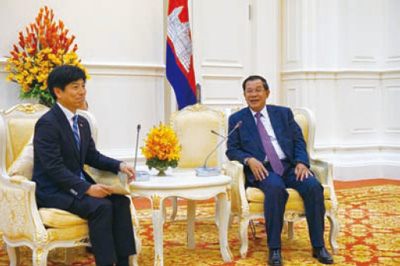 Parliamentary Vice-Minister for Foreign Affairs Nakane pays a courtesy visit to Cambodian Prime Minister Hun Sen (January 15, Cambodia)
Parliamentary Vice-Minister for Foreign Affairs Nakane pays a courtesy visit to Cambodian Prime Minister Hun Sen (January 15, Cambodia)
(6) Singapore
Although Singapore’s political regime led by the People’s Action Party (PAP) remains stable, changes in the political awareness of the people have been seen in recent years. In addition, the Government of Singapore is moving to address issues of major public concern; for example, it has embarked on a partial reform of its hitherto-proactive policy on the acceptance of foreign nationals. In his speech on Singapore’s National Day in 2014, Prime Minister Lee Hsien Loong cited as key issues the enhancement of education systems other than university education, the expansion of support for elderly people (those who founded the country) and those on low incomes, and the improvement of housing conditions. In addition, Singapore is embarking upon generational change, moving forward with the promotion of leadership candidates among the younger generation, which is known as the “fourth generation.”
In terms of relations with Japan, there continued to be a steady stream of visits by key figures in both directions, following on from the previous year. In May, Prime Minister Abe visited Singapore for the second consecutive year; as well as using his keynote address at the Shangri-La Dialogue to inform a wide-ranging audience from the international community about Japan’s security policy, he held a summit meeting with Prime Minister Lee Hsien Loong, at which they agreed to further strengthen cooperation between their countries. The two leaders also held talks during the G20 Summit in November. Minister for Foreign Affairs and Minister for Law of Singapore K. Shanmugam, visited Japan in October and held a Foreign Ministers’ Meeting with Foreign Minister Kishida, during which the two agreed to further enhance collaboration towards the 50th anniversary of the establishment of diplomatic relations between the two countries in 2016.
With regard to economic affairs, many Japanese companies have established regional headquarters in Singapore and partnerships between companies from both countries have been emerging in fields such as infrastructure. Moreover, the two countries have been undertaking a joint technical cooperation programme for developing countries through the Japan–Singapore Partnership Programme for the 21st Century (JSPP21). Intellectual and cultural exchanges between the two countries are also flourishing; for example, the Japan–Singapore Symposium was held in November, with the participation of government officials and experts from the private sector.
(7) Laos
Laos is a landlocked country that is crucial to improving connectivity in the Mekong region, as it shares a border with China, Myanmar, Thailand, Cambodia, and Viet Nam. Its economic development had been retarded by these geographic constraints and past civil war, but in recent years it has been aiming to achieve economic development by improving connectivity, for example, through the establishment of intraregional logistics hubs that take advantage of its location in the center of the Indochinese Peninsula. A single-party state, the domestic situation in Laos is generally stable, under the rule of the Lao People’s Revolutionary Party. Regarding economic affairs, it maintains steady economic growth driven by its electric power and mineral resources, achieving a GDP growth rate of 7.6% (2013/14 Lao fiscal year, Lao Ministry of Planning and Investment).
Japan–Lao relations have traditionally been good and they maintain a comprehensive partnership. In particular, there has been growing interest in Laos on the part of Japanese companies of late, so economic exchanges between the two countries are flourishing, encompassing not only the development cooperation seen hitherto, but also private sector investment. For example, the Japan External Trade Organization (JETRO) opened an office in Laos in July 2014. Moreover, the Air Services Agreement was signed in January 2015, in the presence of Parliamentary Vice-Minister for Foreign Affairs Nakane, during his visit to Laos. The aim of this agreement is to further promote people-to-people exchanges between the two countries. Furthermore, as 2015 marks the 60th anniversary of the establishment of diplomatic relations between Japan and Laos, the two countries set up a liaison committee, which undertook various preparations for the lavish celebrations to commemorate this landmark year.
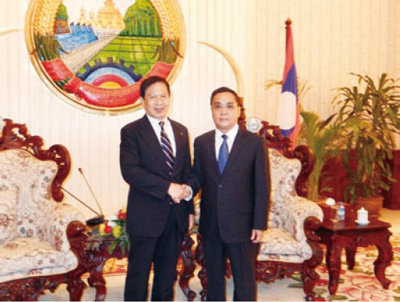 State Minister for Foreign Affairs Mitsuya shakes hands with Prime Minister Thongsing Thammavong of Laos (June 4, Laos)
State Minister for Foreign Affairs Mitsuya shakes hands with Prime Minister Thongsing Thammavong of Laos (June 4, Laos)
(8) Myanmar
Since making the transition to a civilian government in 2011, Myanmar has been undertaking various reforms under the rule of President Thein Sein, including democratization, national reconciliation, economic reform, and strengthening of the rule of law. Some additional initiatives aimed at domestic reform were seen in 2014, ahead of the general election due to take place in 2015, which will be a major turning point in the country’s domestic affairs. These included the establishment of the Constitutional Amendment Implementation Committee to review the amendment of the Constitution, and dialogue aimed at achieving a truce between the government and ethnic minorities.
Myanmar is located in a geographically strategic position between China and India, so it has tremendous development potential. Moreover, the people of Myanmar are well-disposed toward Japan overall, so Japanese companies are very interested in the country. In light of this situation, Japan hopes that its support for Myanmar’s development endeavors will enable the country to develop into one that contributes to the prosperity and stability of the region as a whole. In particular, 2014 was a symbolic year for the friendly relationship between Japan and Myanmar, as it marked the 60th anniversary of the establishment of diplomatic relations between the two countries, with an array of exchange events taking place. Moreover, Myanmar served as Chair of ASEAN in 2014, the first time that it had occupied the role since its accession to ASEAN in 1997.
It was amid this situation that Foreign Minister Kishida made official visits to Myanmar in March and August 2014. In November, having been to Myanmar the previous year, Prime Minister Abe again visited the country, this time to attend the meeting of the leaders of ASEAN member states and associated nations. During this visit, the Prime Minister announced that both the public and private sectors in Japan would support the reform efforts being made by the Government of Myanmar. All of this helped to enhance dialogue and the cooperative relationship between the two countries as they celebrated the 60th anniversary of the establishment of diplomatic relations, with a view to further development of Japan–Myanmar relations in the future. In July, the Japan–Myanmar Investment Agreement entered into force; this is Myanmar’s first investment treaty based on full-scale liberalization. With regard to development cooperation, during Prime Minister Abe’s 2013 visit, he announced the provision of Japanese ODA loans worth 51 billion yen and grant aid and technical cooperation worth a total of 40 billion yen. By the time of the March 2014 visit by Foreign Minister Kishida, all of this assistance had either been implemented or an exchange of notes concerning the assistance had been signed. Moreover, between April and the Leaders’ Meeting in November, Japan announced the provision of additional Japanese ODA loans totaling 124.2 billion yen. Furthermore, reconciliation with ethnic minorities, which has been an unresolved issue since the country’s independence, is essential to reform in Myanmar. Accordingly, under Japan’s doctrine of making a “Proactive Contribution to Peace” based on the principle of international cooperation, Ministry of Foreign Affairs (MOFA) is working in partnership with Yohei Sasakawa, Special Envoy of the Government of Japan for National Reconciliation in Myanmar, to support the peace process between the Government of Myanmar and the country’s ethnic minorities. In January 2014, the Government of Japan announced that it was prepared to provide 10 billion yen in support over the next five years, depending on progress in the peace process.
(9) Thailand
Located at the heart of the Mekong region, Thailand is one of the major countries of Southeast Asia and has a Strategic Partnership with Japan. As a result of investment over many years, a large number of Japanese companies do business in Thailand and the country has become absolutely crucial to the Japanese economy as a key role in global supply chains.
With society deeply divided between those who support former Prime Minister Thaksin Shinawatra, who was ousted from power as a result of the 2006 coup d’état, and those who condemn him, demonstrations and violence continued to affect government functions and civic life in 2013 and 2014. In response, the Thai military launched a coup d’état in May 2014, with the aim of bringing the situation under control. The military administration installed a handpicked legislature and interim Cabinet, and the process of drafting a new constitution has begun, but concerns have been expressed both within the country and overseas concerning the ongoing imposition of martial law, restrictions on freedom of speech, and the suppression of human rights. Moreover, although the roadmap set out by the military administration for returning the country to civilian rule envisages that the new constitution will be enacted in 2015 and that this will be followed by parliamentary elections, there are many uncertain factors.
Building on the close relationship between the Imperial family and the royal family, interaction between Japan and Thailand takes place at a variety of levels, including political and economic exchange. To support efforts to stabilize Thailand and return it to civilian rule, as well as deepening relations between the two countries, Japan–Thailand Summit Meetings took place in October 2014 during the 10th Asia–Europe Meeting (ASEM) Summit and in November during the meeting of the leaders of ASEAN member states and associated nations. In addition, the Japan–Thailand Foreign Ministers’ Meeting took place in September during the UN General Assembly, and Prawit Wongsuwan, who holds the posts of both Deputy Prime Minister and Defense Minister, visited Japan in November.
As a result of Japan’s launch in 2013 of a visa waiver for short-term visits by Thai nationals, the number of Thai visitors to Japan in 2013 as a whole rose to approximately 450,000, up by more than 70% from the previous year.
(10) Viet Nam
Located next to sea lanes in the South China Sea and sharing a long border with China, Viet Nam is a geopolitically important country. In addition, it has the third-largest population in Southeast Asia and is experiencing a surge in the number of those in middle-income brackets, making it a key market for the future. With the aim of becoming an industrialized country by 2020, Viet Nam is striving to attract foreign capital by developing infrastructure and improving the investment environment, and is also promoting reforms focused on the disposal of bad loans and the restructuring of state-owned enterprises. It seems that Viet Nam has overcome the stagnation that has beset the domestic economy since the latter half of the 2000s.
With regard to domestic affairs, members of the Cabinet and other officials faced a confidence vote in the National Assembly in November 2014, following a similar vote the previous year. Moreover, besides a constitutional amendment adopted by the National Assembly in 2013 put in place a new provision stipulating that the Communist Party of Vietnam (CPV) shall submit to the supervision of the people and is accountable to the people for its decisions, a vote of confidence in the leadership of the CPV was conducted for the first time in its history at the 10th Plenary meeting of 11th Party Central Committee. These moves are seen as demonstrating that the CPV is aware of the importance of securing the support of the populace.
Tensions emerged in the relationship between China and Viet Nam over China’s placement of an oil rig in the South China Sea (in water off the Paracel Islands) in May 2014. It appears that Viet Nam retains a sense of caution towards China, even though the rig was removed in July.
In terms of relations with Japan, President Truong Tan Sang made a state visit to Japan in March 2014, during which the two countries agreed to upgrade their bilateral relationship to that of an “Extensive Strategic Partnership.” Moreover, there were numerous reciprocal visits by the leaders and Cabinet members of both countries, helping to deepen relationships of trust at the political level. In July, Foreign Minister Kishida visited Viet Nam for the 6th Meeting of the Japan–Viet Nam Cooperation Committee. At the meeting, both sides agreed to enhance cooperation in fields including agriculture, the development of supporting industry, energy, and human resource development. In addition, Japan announced that it would provide used vessels and related equipment to enhance Viet Nam’s maritime law enforcement capabilities.
Japan is Viet Nam’s largest donor of Official Development Assistance (ODA) and its second-largest source of investment.
(11) Timor-Leste
As the first new sovereign state of the 21st century, Timor-Leste has achieved peace and stability with the support of the international community and has been engaged in nation-building based on democracy under the leadership of President Taur Matan Ruak and Prime Minister Xanana Gusmão. Currently, the country is in transition from post-conflict reconstruction to full-scale development under the Strategic Development Plan (long-term guidelines for development starategy until 2030) formulated in 2011. In July 2014, the summit of the Community of Portuguese Language Countries (CPLP) was held in its capital, Dili, marking the first time Timor-Leste hosted an international conference.
Japan continues to provide comprehensive support for Timor-Leste’s efforts as it movesfrom the post-conflict reconstruction into full-scale development, while continuing to workclosely with Timor-Leste in the international arena as well. In addition, Japan supports Timor-Leste’s goal of a smooth accession to ASEAN, including through assisting in human resource development towards the achievement of its goal.
High-level visits between the two countries continue to flourish. From Japan, State Minister for Foreign Affairs Norio Mitsuya visited Timor-Leste in May. From Timor-Leste, Minister of Public Works Gastão Francisco de Sousa and Minister of Agriculture and Fisheries Mariano Assanami Sabino visited Japan in April. In addition, First Vice President of the National Parliament Adriano do Nascimento, and two commissions from the National Parliament visited Japan and had a exchange of views with senior members of the Government of Japan.
― First Dispatch of the Japan Coast Guard’s Gulfstream V Aircraft ―
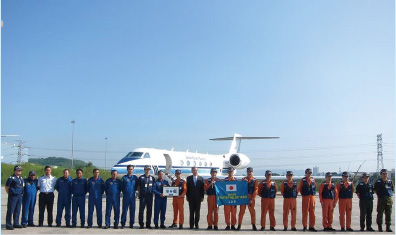 Gulfstream V moves from Malaysia to Australia (26 March, Subang Airport, Malaysia)
Gulfstream V moves from Malaysia to Australia (26 March, Subang Airport, Malaysia)
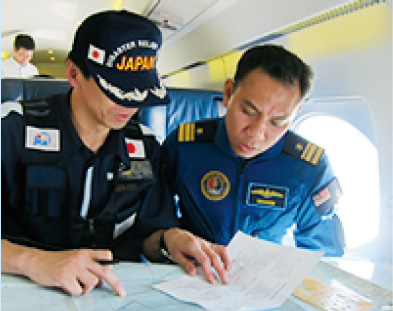 Joint searches with staff of the Malaysian Maritime Enforcement Agency in the Gulfstream V aircraft
Joint searches with staff of the Malaysian Maritime Enforcement Agency in the Gulfstream V aircraft
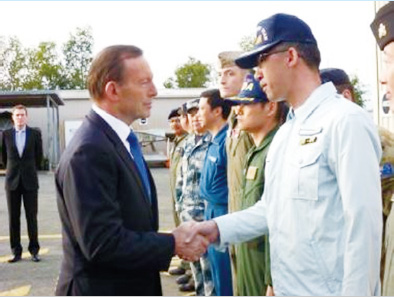 Prime Minister Abbott of Australia encouraging the commanding officers from the respective countries
Prime Minister Abbott of Australia encouraging the commanding officers from the respective countries
On 8 March 2014, the whereabouts of a Malaysia Airlines plane (flight MH370) became unknown. In response to the request of the Malaysian government, on 11 March, Japan decided to dispatch Japan Disaster Relief (JDR) Team . This team comprises members from the Ministry of Foreign Affairs, Ministry of Defense, Japan Coast Guard, and JICA.
This article will feature the activities undertaken by the Japan Coast Guard’s Gulfstream V aircraft, which was dispatched for the first time under the framework of JDR. Between 12 March and 4 April, Japan Coast Guard dispatched a Gulfstream V aircraft with a total of 28 personnel to conduct search efforts. During this period, the team worked hard to look for the missing aircraft from bases in Kuala Lumpur (Malaysia) and Perth (Australia), conducting two searches in waters east of the Malay Peninsula, four searches in waters south of Indonesia’s Java Island, and five searches in waters west of Perth in Australia. Unfortunately, these searches did not turn up any signs of the missing aircraft.
Search and rescue efforts in Malaysia included cooperating and collaborating with staff of the Aeronautical Rescue Coordination Centre (ARCC) to decide on the search area that Japanese aircraft would take charge of, as well as the boarding of two staff members from the Malaysian Maritime Enforcement Agency on the Japan Coast Guard aircraft to conduct searches jointly. Activities were carried out in close cooperation with the local agencies.
Activities by the Japanese representatives were widely covered by the local and overseas press in Malaysia and Australia, and the team received expressions of gratitude for their support activities wherever they went. (For example: From ARCC, “We are happy that an all-Japan team has come to our assistance.” From airline agents, “We are honored to receive Japan’s assistance in the search activities.”) The local governments also expressed their gratitude toward these activities.
Last but not least, I would like to thank the Japanese Embassy, Consulate General, the JICA office, and many other people for their support, as well as the all-Japan JDR team for their excellent teamwork. It is also my earnest wish that the missing Malaysia Airlines aircraft will be found as soon as possible.
Hideo Tojo,
Administration Division, Guard and Rescue Department, Japan Coast Guard
(Advance Team of the Japan Disaster Relief (JDR) Team)

